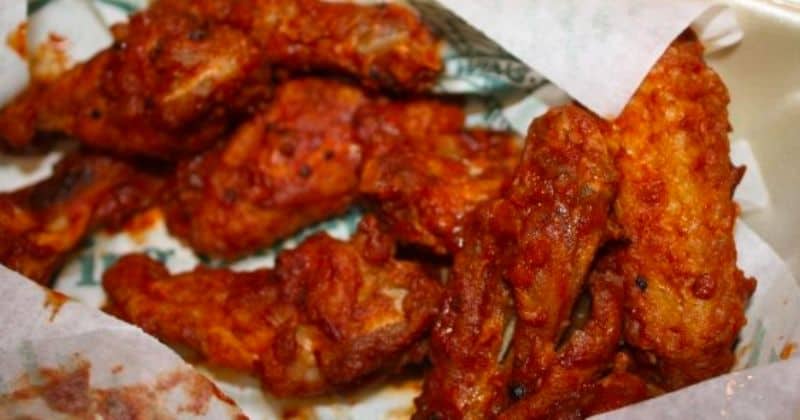If you love spicy chicken wings, getting braces may seem like a buzzkill. Suddenly you have to navigate eating with a mouth full of wires and brackets. At first glance, crunchy chicken wings and braces don’t seem like an ideal mix. But don’t start mourning the loss of your favorite fiery snack just yet!
The answer is yes, you can absolutely eat chicken wings with braces. With some simple precautions, wings can still be on the menu. The keys are taking your time, cutting wings into smaller pieces, and removing bones before eating. Follow these tips, and you can keep enjoying those saucy wings without sacrificing your braces.
This guide will walk you through how to choose, prepare and eat chicken wings safely with braces. We’ll share steps like:
- Cooking wings to tenderize the meat
- Deboning wings before eating
- Chopping meat into bite-sized portions
- Chewing carefully with back teeth
We’ll also answer common questions about eating different types of wings with braces – like boneless, breaded or ultra-spicy hot wings.
While wing eating requires some extra care, we’ll show you how to make it work. So read on for tips to enjoy your favorite chicken wings without wreaking havoc on your braces!
Overview: Eating Wings With Braces

The good news is you can eat chicken wings with braces. The keys are taking your time, cutting the wings into smaller pieces, and removing the bones. This prevents damage to your braces from biting into something too hard or getting bones stuck.
Here’s a quick summary of how to eat wings with braces:
- Soften the wings – Cook them until tender so they’re easier to bite through.
- Debone the wings – Slice off each section and pull out the bones.
- Cut meat into pieces – Chop cooked wing meat into smaller, bite-sized portions.
- Chew carefully – Use your back teeth and chew slowly. Don’t bite directly into meat.
Follow these tips and spicy wings can still be on the menu. Let’s look at the process in more detail.
Choosing the Right Wing Sauces
While sauces are what give wings their signature zing, not all sauces pair well with braces. Thick, sticky sauces have more potential to get lodged in wires or brackets.
When choosing a wing sauce, look for these braces-friendly qualities:
- Thin consistency – Vinegar-based sauces that coat wings are better than thick, gloppy sauces. The thinner the sauce, the less likely it is to stick.
- Dry rubs – Skip the sauce and use a flavorful dry
spice blend. It adds tons of flavor without sauce issues. - Lighter glazes – Sweet glazes made with honey, bourbon, soy, etc. add flavor without being too thick or sticky.
- Oil-based sauces – Sauces with an oil base tend to be thinner than cream or cheese-based sauces.
Some sauces to be cautious with include:
- Thick tomato or cream-based sauces – These creamy sauces are prone to sticking in braces.
- Sugary sweet BBQ sauces – The high sugar content makes these extra sticky. Opt for a lighter glaze.
- Buttery buffalo sauces – Lots of melted butter makes sauces thick and gluey.
Choosing more thin, vinegar-forward sauces prevents excess sticking and potential damage to your braces. Focus on flavor, not just heat or thickness.
Step 1: Soften Your Wings
Fresh out of the fryer, chicken wings can be too crunchy and firm to eat comfortably with braces.
The first step is to cook the wings until the meat is tender and easier to bite through. There are a couple ways to do this:
- Bake or grill the wings until completely cooked through and the meat pulls back from the bone.
- Parboil or steam the wings for 5-10 minutes before baking or frying to soften them up.
Cooking makes the meat moist and soft for easier, safer eating. Avoid eating extra crunchy or undercooked wings, as they’ll be too hard to bite through.
Step 2: Debone the Chicken Wings
The bones in wings can damage braces and are a choking hazard. So the next step is to remove all the bones before eating.
Here’s a simple process to debone wings:
- Separate the drumette – Use a knife to cut through the joint connecting the drumette and flat.
- Peel back the meat – Run your fingers between the bone and meat to loosen.
- Pull out the bones – Grab the top of the bone and slide it out of the meat.
- Remove any fragments – Double check both sections for any remaining small bones.
This leaves you with soft, boneless chicken wing meat ready to enjoy sans braces stress!
Step 3: Cut Wings Into Bite-Sized Pieces
Even after deboning, whole chicken wings are too large to eat comfortably with braces.
Next, use a knife to cut the wing meat into smaller, bite-sized pieces. Try these tips:
- Aim for 1-2 inch pieces – This makes meat easy to fully chew with braces on.
- Cut across the grain – Slice perpendicular to the meat fibers for shorter muscle strands.
- Separate drumette and flat – Cut these thicker sections into multiple smaller pieces.
- Discard excess skin or fat – Trim off any hard, chewy non-meat bits.
Proper slicing makes wings easier and safer to eat. Now you’re ready for the fun part – eating!
Step 4: Chew Wings Carefully With Your Back Teeth
You love wings for the juicy meat, crispy skin, and spicy flavors. With braces, enjoy all that while taking care not to damage those expensive dental treatments!
Here are tips for chewing wings with braces:
- Use back teeth to chew – Avoid biting directly into meat with front braces.
- Chew slowly and thoroughly – Break down meat completely before swallowing.
- Don’t pull with teeth – Yanking can loosen brackets. Cut meat into small pieces instead.
- Check for stuck food – Carefully swish water after eating to clear debris.
Take your time and chew deliberately. The better you break down meat, the lower the risk of mishaps.
Troubleshooting Wings with Braces Issues

Even if you take all the proper precautions, wings can still potentially cause minor braces issues. Here are some troubleshooting tips if wings are proving tricky:
- Soak wings longer – Increase marinade time to really soften and tenderize the meat before cooking.
- Cut smaller pieces – Stick to 1-inch or smaller pieces to make chewing easier on your braces.
- Hold sauce on the side – Don’t douse wings in sauce. Instead, dip pieces lightly to control sauce amount.
- Cook thoroughly – If wings still seem too hard or chewy, try baking them a bit longer.
- Use a softer sauce – Substitute thick cream-based dips with something gentler like Greek yogurt ranch.
- Rinse thoroughly after eating – Swish water around your mouth to clear any sauces or debris.
- Avoid husky bites – Don’t try to tear meat with your teeth. Cut all meat into small pieces first.
- See your orthodontist – If irritation persists, consult your orthodontist to check for any appliance issues.
Stay vigilant while eating and make adjustments as needed. With some extra care, wings and braces can coexist beautifully.
The Nutritional Value of Chicken Wings
Besides tasting great, wings also offer some nutritional value. Here are some of the benefits of including them in your braces-friendly diet:
- Protein – Wings provide over 25g of protein per 3-4 wing serving. Protein promotes strong teeth and bones.
- Iron – Wings contain around 1mg of iron per serving to support blood health.
- B Vitamins – Riboflavin, niacin and pyridoxine in wings aid carbohydrate metabolism for dietary balance.
- Sodium – The salt in wings improves electrolyte balance. Just watch your total intake if limiting sodium.
- Zinc – Found in wings, zinc promotes immune function and wound healing in the mouth.
Chicken wings make a tasty occasional snack or meal that also provides valuable vitamins and minerals when eaten in moderation.
Healthy Cooking Tips for Chicken Wings
Wings get a bad rap as an unhealthy food due to being fried. But cooked right, they can be a nutritious addition to your diet. Consider these healthy tweaks:
- Bake instead of fry to reduce total fat and calories.
- Use healthier oils like olive or avocado oil if roasting.
- Skip butter-drenched sauces and use lighter rubs and glazes instead.
- Eat with crunchy fresh veggies like celery and carrot sticks for balance.
- Portion control – stick to 3-4 wings per serving.
Eaten occasionally and prepared with care, wings can be part of an overall nutritious braces-friendly diet.
The Final Word on Eating Wings With Braces
So can you savor spicy wings while wearing braces? The answer is yes! With some simple preparation and eating care, wings can still be on the menu. Here are the key takeaways:
- Cook wings until tender and debone thoroughly before eating.
- Chop meat into small, bite-sized pieces.
- Chew very slowly and carefully using your back teeth.
- Rinse your mouth after eating to clear any debris.
- Take precautions when eating hot or breaded wings.
- Enjoy wings in moderation as part of a balanced braces diet.
While wings require a bit more work, the extra effort means you don’t have to miss out on their zesty flavors. With the techniques in this guide, you can keep enjoying spicy wings safely with braces. Just be patient, take your time, and eat carefully. Happy chicken wing eating!
FAQ: Eating Wings With Braces
Boneless wings offer an even easier braces-friendly alternative. Here are some common questions about eating these saucy treats with braces:
Can you eat boneless wings with braces?
Yes, you can safely eat boneless chicken wings with braces. Without bones, they carry very little risk of damaging wires or brackets.
What precautions should you take?
You still need to cut boneless wings into bite-sized pieces before eating. Don’t bite off more than you can chew. Also beware of gristle, fat or skin getting stuck.
Are breaded boneless wings ok?
The breading can detach and may irritate braces. Make sure to chew thoroughly until very smooth. Consider ordering grilled or sauced boneless wings instead.
How do you debone boneless wings?
No deboning needed! They come ready to eat, just cut into pieces. You can remove any fatty bits or cartilage if desired.
Boneless wings are a great low-risk braces option. Just take care when chewing.
Can you eat hot wings with braces?
Fortunately, spicy heat will not damage or impact braces in any way. So you can still enjoy hot wings without worrying about your brackets.
Will hot sauce stain braces?
It’s possible. Sauce and seasoning may temporarily discolor bands or wires. But this is only a cosmetic issue. Thoroughly rinse your mouth after eating.
Do hot wings impact braces pain?
Irritation from spices could make tender teeth and gums more sensitive shortly after eating. Take care chewing and rinse your mouth to relieve any burning sensation.





